IF YOU THOUGHT PAUL GIAMATTI’S CHARACTER in Sideways was obsessed, consider the growing cult of American oenophiles for whom only ultranatural “biodynamic” wine will do.
Biodynamic Wine

Vintners producing this exalted juice concoct compost by burying cow dung packed in cow horns in the fall, unearthing them in the spring, and “dynamizing” the muck by stirring it with rainwater in alternate directions before spraying it on the soil. Cosmic and lunar cycles dictate when to harvest and when to bottle. Got buggy pests? When the moon is in Scorpio, burn some of the bastards and spread their ashes as a warning to others.
The belief behind these lavish devotions, based on the 1920s writings of Austrian philosopher Rudolf Steiner, is that the tastiest grapes grow in soils treated like living beings that can be exhausted by overuse and chemicals. After decades of slow growth in France, the practice has caught hold in the U.S. The first American vineyard was certified biodynamic in 1996; today, 14 are certified, with 11 more working toward approval. Still, nobody can say for sure how the rituals lead to such fine wine. “Whether it’s biodynamics or all that attention, something enhances the flavor, the health of the fruit,” says New York City–based master of wine Mary Ewing-Mulligan.
I gathered some California biodynamic reds for a raucous dinner that ended in slurpy talk. Compared with traditionally grown varietals, Frey Vineyards’ 2002 Cabernet Sauvignon ($14), and the 2000 Four Vineyards Pinot Noir ($46) and 2001 Los Carneros Cabernet Franc ($36), both from Robert Sinskey, tasted more like the piquant little apricots I grew last summer than the fat, indifferent ones I bought at the supermarket in January. The real test was pitting these American wines against an American meal of corn bread and bison chili with New Mexico peppers. While the flavors of all three stayed vibrant, the winner was Sinskey’s cabernet franc, which was so full of nuances and dark secrets, I went into our garden after the last glass and bayed at the moon.
(Ching Bling)
Mountaineers looking to keep their cool on high typically rely on a flask and mild hypoxia. But last year, some began wearing a New Agey neck charm purported to enhance performance under stress. Introduced in 1995 by Larkspur, California–based Clarus Products International, the Q-Link holds crushed minerals that the company says balance the body’s “biofield,” boost-ing endurance and mental clarity. Clarus points to clinical studies (mostly cellular) to back the claims, though many mainstream scientists scoff. Clarus has sold a quarter-million of the peppermint-pattie-size ornaments—choose from acrylic ($130), silver ($300), or gold ($840)—and they’ve been a hit with PGA golfers. In the Himalayas, Q-Links have been spotted on Mountain Madness guides and 8,000-meter-peak veteran Michael O’Donnell, 48, who says it helped him fight exhaustion on Tibet’s 26,906-foot Cho Oyu. But don’t expect your base-camp doctor to push them just yet. “Mountain sickness is so subjective, you’ll have a big placebo effect,” says Dr. Peter Hackett, the recently departed president of the International Society of Mountain Medicine. “It could help mountaineers simply because they think it does.” —Adam Skolnick


